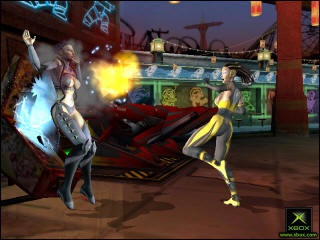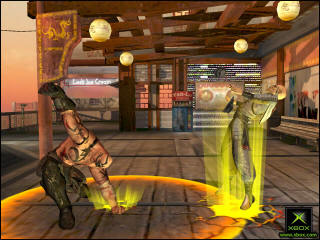 A dozen fighters, each with a surprisingly deep back-story, are packed into the game. Their designs are mildly unique, though giving them names like "Fiery Phoenix" is not. It basically revolves around the good-evil conflict between two groups, the Pale Lotus and the Black Mantis, in a fictional China. The quest mode fleshes out the feud as you take one character and fight the opposite sect for control. If that's too deep, just go for the versus, survival, or team battle.
A dozen fighters, each with a surprisingly deep back-story, are packed into the game. Their designs are mildly unique, though giving them names like "Fiery Phoenix" is not. It basically revolves around the good-evil conflict between two groups, the Pale Lotus and the Black Mantis, in a fictional China. The quest mode fleshes out the feud as you take one character and fight the opposite sect for control. If that's too deep, just go for the versus, survival, or team battle.
There are multiple glaring issues with the gameplay system in use here. Notably is the reluctance to get away from the dial-a-combo system that ran the "Mortal Kombat" series into the ground for a while. There's little skill involved when you have to memorize very precise button combos to inflict damage. It gives the game its overly stiff and hard to control feel. When done right, it all looks spectacular in motion, much like a kung-fu movie. That's assuming you wish to spend hours with a strategy guide or instruction book and a good fighter doesn't (shouldn't actually) require that.
The chi meter is another wasted aspect. As the fight moves on, the meter grows; allowing the lucky fighter to launch a brutal attack or heal damaged limbs. Yes, you can hurt specific areas of the body, though it usually ends up being the arms when the opponent blocks too much. When damaged, that person's defense stays at the same level but their offense decreases. It's a nice way to prevent players from constantly blocking, though if their arm is broke, shouldn't it hurt them to stop a kick with it?
 Oddly, the left analog stick can be set to free movement. Why you actually have to turn this on during the initial boot up doesn't make any sense. The d-pad controls the basics (blocking, ducking, etc.) but not 3-D movement. Since the game allows for attacks off of objects (like poles and walls), it's imperative to be able to move towards them. That makes for some intriguing moves, though they can be hard to land. Juggling is allowed and can result in some great sights, but again, it's far more fun to look at then it is to play.
Oddly, the left analog stick can be set to free movement. Why you actually have to turn this on during the initial boot up doesn't make any sense. The d-pad controls the basics (blocking, ducking, etc.) but not 3-D movement. Since the game allows for attacks off of objects (like poles and walls), it's imperative to be able to move towards them. That makes for some intriguing moves, though they can be hard to land. Juggling is allowed and can result in some great sights, but again, it's far more fun to look at then it is to play.
The big selling point here is real-time damage. It's nifty even if doesn't work as advertised nor is it really specific to a location. Once the life bar has been drained (which needs to be done three times to win a match instead of the round system), a close-up of the beaten fighter is shown to reveal the damage. However, if you hit them in the face, their legs might bleed. Most of it just seems pre-determined to happen as the fight moves deeper, all the needed textures ready to go at a moments notice.
Each of those bloodied up models looks great, whether at a distance or up close. The same goes for the rather unique destructible backgrounds. Nothing can match slamming an enemy through an arcade cabinet, especially when it all looks this good. Lighting is spectacular and the details, especially in the clothing (including multiple layers thanks to transparencies) are amazing. These characters are simply packed with polygons and the entire game benefits from it.
 The audio presentation benefits from a great announcer who explains each match in the Quest mode. During pre-fight, he goes over the entire story of just why you're about to engage the enemy. He does this with force and style. Each hit, especially those that break objects, is accompanied by a brutal shot of bass. You'll feel each hit. The music is a bit of a downer, suited to each stage, but neglected to the background and seemingly forgotten.
The audio presentation benefits from a great announcer who explains each match in the Quest mode. During pre-fight, he goes over the entire story of just why you're about to engage the enemy. He does this with force and style. Each hit, especially those that break objects, is accompanied by a brutal shot of bass. You'll feel each hit. The music is a bit of a downer, suited to each stage, but neglected to the background and seemingly forgotten.
"Tao Feng" is a game that Tobias obviously wanted to go back on top with. It has some great ideas, separates itself well from the competition, and it's probably the best overall looking fighter on the system. Unfortunately, all of these great ideas are revolving around a gameplay engine that feels archaic and well behind the times. This is a game far better in parts than it is as a whole.